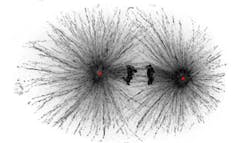Laser microsurgery helps uncover how centrioles contribute to cell division
A team of scientists at the University of Vienna and the Medical University of Vienna (both in Vienna, Austria) is examining how cylindrical organelles called centrioles contribute to mitosis (cell division), the process by which the genetic information encoded on chromosomes is equally distributed to two daughter cells. The findings help to better understand the function of centrioles in mitosis.
Correct mitosis requires the formation of a filamentous spindle that ensures that chromosomes are separated to opposite ends of the cell. Similar to ropes pulling a heavy weight, the spindle needs an anchor point from where it can develop. This point is provided by centrioles that accumulate a protein meshwork called the pericentriolar material (PCM) around them to form centrosomes, which serve as both the origin and attachment site for the filaments of the mitotic spindle.
While it was known that centrioles are essential for the initial formation of the centrosome, their role in further mitotic growth and maintenance of the PCM throughout cell division was previously unclear. The scientists were able to answer these questions with the help of C. elegans, a model organism that has exceptionally large centrosomes. Using laser microsurgery, they were able to remove the centrioles from within the centrosome at different stages of mitosis without destroying the entire structure.
Related: Laser microscopy helps track key component of cell division
"What we found was that centriole ablation did not lead to an immediate collapse of the PCM as we had expected," explain Triin Laos and Gabriela Cabral, the journal paper's first authors, who are working under the leadership of Alexander Dammermann. "However, further growth was strongly impaired, revealing a critical role for centrioles in PCM accumulation, and therefore mitotic spindle assembly."
Beyond their role in PCM assembly, centrioles are also essential for structural integrity, with acentriolar centrosomes liable to being pulled apart as cells proceeded through mitosis. This finding was particularly remarkable, given the small size of centrioles relative to the surrounding PCM. How centrioles could confer structural integrity to a structure >30X larger is not immediately clear.
The research team foresees that centrioles provide anchor sites for proteins that impart tensile strength to the PCM by acting similar to steel bars in reinforced concrete. By controlling PCM assembly and structural integrity, centrioles then have critical roles throughout cell division. How centrioles perform these apparently disparate functions remains the biggest open question, the authors agree.
Full details of the work appear in the journal Developmental Cell.
